Marrying Vega and Zen: The AMD Ryzen 5 2400G Review
by Ian Cutress on February 12, 2018 9:00 AM ESTiGPU Gaming Performance
Throughout their history of having fully integrated GPUs, AMD has always favored going for powerful configurations that approach the lower-end of discrete GPU performance. With comparable discrete cards going for $80 or more, a powerful iGPU is a significant value proposition for AMD’s APUs. Furthermore as Intel has continued to stick with relatively lightweight iGPUs for most mainstream SKUs – a trend even the newly released “Coffee Lake” 8th Gen Core family continues – AMD has easily trounced Intel’s iGPU performance.
In fact the most recent 8th Gen Core CPUs generally fail to catch up to AMD’s last-generation 7000/8000 series “Kaveri” APUs, which means that for the launch of AMD’s new Ryzen APUs, the manufacturer is just going to be running up the lead even more. The real question we’ll be looking at on the iGPU side isn’t what’s faster – that’s obvious – but just how many times faster the 2400G & 2200G APUs are over their Intel equivalents, and how they stack up against an entry level discrete video card, the GeForce GT 1030. With upwards of 11 CUs in an APU, on paper the Ryzen APUs should be able to offer 1080p@30fps gaming at maximum (or near-maximum) image quality.
During our pre-briefing, several sets of benchmarks and configurations were 'suggested', focusing on eSports and a mid-range quality setting, to show what the platform can do. For our testing, we used our CPU Gaming 1080p gaming suite. This suite was developed with mid-range and high-end graphics cards in mind, with mostly high or ultra quality settings, pushing beyond what was suggested. The reason we did this was two fold:
- In our data, it shows a sizeable difference between integrated graphics solutions that can offer potential, compared to those that fall at the first hurdle.
- Second, it offers a stark reminder that while for the most part websites and enthusiasts like as way lyrical about high-end performance, the data shows both how far integrated graphics has come, and how far it still has to go to qualify for those 'immerse experiences' that Intel, AMD, and NVIDIA all claim are worth reaching for, with higher resolutions and higher fidelity.
Civilization 6
First up in our CPU gaming tests is Civilization 6. Originally penned by Sid Meier and his team, the Civ series of turn-based strategy games are a cult classic, and many an excuse for an all-nighter trying to get Gandhi to declare war on you due to an integer overflow. Truth be told I never actually played the first version, but every edition from the second to the sixth, including the fourth as voiced by the late Leonard Nimoy, it a game that is easy to pick up, but hard to master.
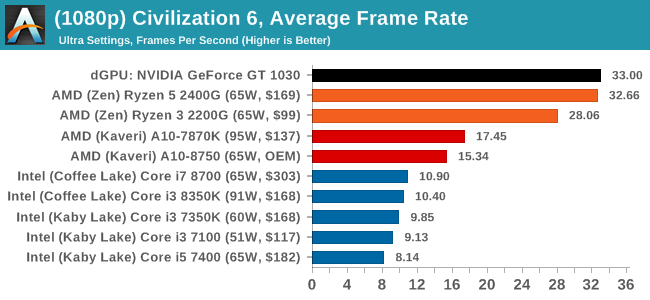

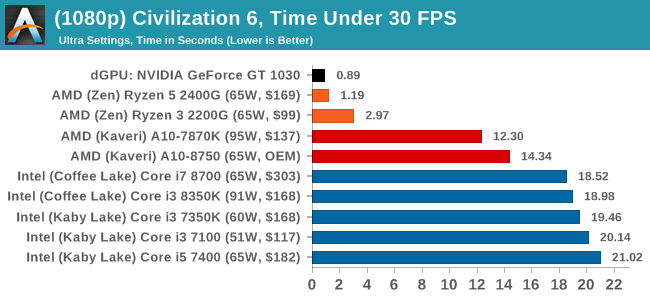
While Civilization is not too limited to frame rates, the APUs straddle the 30FPS average, and the GT 1030 comes out on top just about. Intel's integrated graphics options are only 1/3 of what AMD is providing in this case.
Shadow of Mordor
The next title in our testing is a battle of system performance with the open world action-adventure title, Middle Earth: Shadow of Mordor (SoM for short). Produced by Monolith and using the LithTech Jupiter EX engine and numerous detail add-ons, SoM goes for detail and complexity. The main story itself was written by the same writer as Red Dead Redemption, and it received Zero Punctuation’s Game of The Year in 2014.
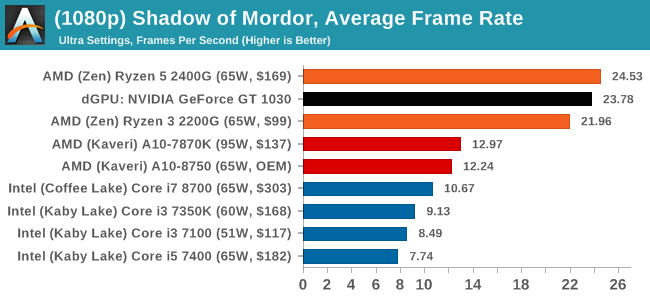
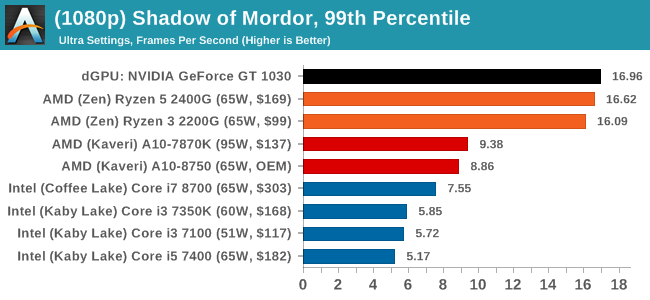
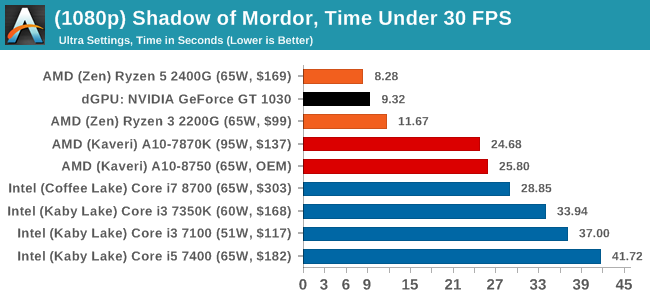
In Shadow of Mordor, the 2400G takes the top spot in average frame rates, but the GT 1030 just wins on percentiles. Over Kaveri, AMD is now offering double the graphics performance, and over Intel, AMD is easily 2-3x in performance per dollar.
Grand Theft Auto V
The highly anticipated iteration of the Grand Theft Auto franchise hit the shelves on April 14th 2015, with both AMD and NVIDIA in tow to help optimize the title. GTA doesn’t provide graphical presets, but opens up the options to users and extends the boundaries by pushing even the hardest systems to the limit using Rockstar’s Advanced Game Engine under DirectX 11. Whether the user is flying high in the mountains with long draw distances or dealing with assorted trash in the city, when cranked up to maximum it creates stunning visuals but hard work for both the CPU and the GPU.
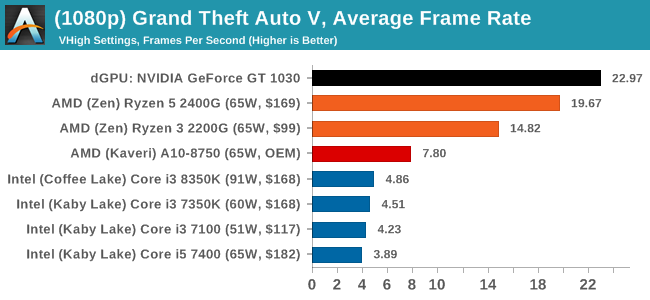
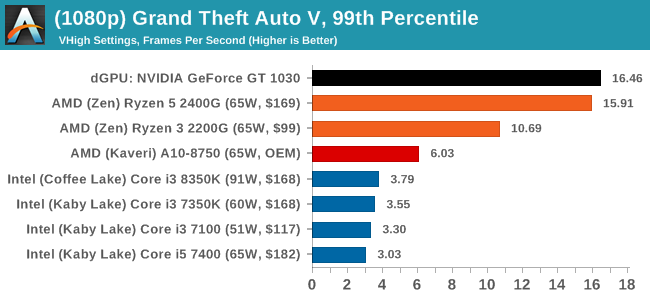

The difference between something playable and a slide show was easily noticable in GTA. The GT 1030 had the legs on this one, although the gap between the two AMD parts was mostly noticable in 99th percentile numbers.










177 Comments
View All Comments
HStewart - Monday, February 12, 2018 - link
I don't get the idea of desktops except if you want ultimate gaming PC - go with High End CPU a long with High End GPU. Otherwise go mobile. You can pretty much go that route unless you desired extreme top end performanceIf you primary into game get a Xbox One X or S and HDTV are cheap or PS 4,
But lower end desktop PC - I see no need them for now. Times have changed
Lolimaster - Monday, February 12, 2018 - link
If you wanna upgrade a laptop, be prepared for a bunch of cabling.Have 3-4 drives on mobile?
Dedicated capture/sound card?
Keep your thermals in check?
Upgrade your cpu/apu whenever you like?
mikato - Saturday, February 17, 2018 - link
To me laptops are annoying, and only convenient for basic tasks with their mobility. Otherwise they are slow, have a small screen, often don’t a have mouse, and no number pad on keyboard. As a result, typing is slower, pointing is slower, app speed is slower, and gaming performance is worse. With the smaller screen, juggling things, dragging files, etc is more difficult. I just can’t get stuff done as well on a laptop as a desktop.oldschool_75 - Monday, February 12, 2018 - link
Why do the Intel systems have 32 gigs of ram while the AMD systems only have 16?Also bulldozer was not 2 cores 4 threads, it was two modules with two cores sharing the modules so 4 cores.
Lolimaster - Monday, February 12, 2018 - link
Why use 2933 memory?As far as i know AMD send 3200 CL14 Flare X to pretty much everyone for the sake of testing the gpu at 3200 CL14 !!!!
jjj - Monday, February 12, 2018 - link
They use the frequencies officially supported , anything above that is OC and would fall into the OC section. It's debatable how right or wrong that is but that's what AT does.Lolimaster - Monday, February 12, 2018 - link
Guru3d got the reviewer's kit with 3200 cl14 flare-x as 100% of the techtoubers too.ScottSoapbox - Monday, February 12, 2018 - link
The number of typos in the first two sentences was enough for me to stop reading.Lolimaster - Monday, February 12, 2018 - link
The avrg l3 latency for non-APU multiple CCX Ryzen's was around 11-12ns, on the single CCX APU is aroun 9.5ns.Memory latency Ryzen
91ns DDR4 2400
77ns DDR4 3200
2400G
66ns DDR4 3200
Macpoedel - Monday, February 12, 2018 - link
Good to see you started testing CPU's with maximum supported RAM speed instead of JEDEC frequency. These APU's would have really suffered if tested with 2133MHz DDR4 RAM.